Hitachi SB 8V2 User Manual
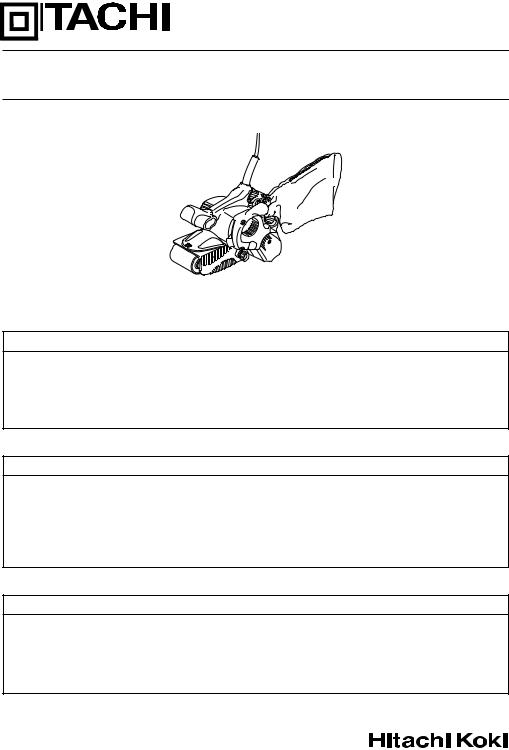
Model
Modèle
Modelo
SB 8V2
Belt Sander Ponceuse à courroie Lijadora de banda
SAFETY INSTRUCTIONS AND INSTRUCTION MANUAL
 WARNING
WARNING
IMPROPER OR UNSAFE use of this power tool can result in death or serious bodily injury!
This manual contains important information about product safety. Please read and understand this manual BEFORE operating the power tool. Please keep this manual available for other users and owners before they use the power tool. This manual should be stored in safe place.
INSTRUCTIONS DE SECURITE ET MODE D’EMPLOI
 AVERTISSEMENT
AVERTISSEMENT
Une utilisation INCORRECTE OU DANGEREUSE de cet outil motorisé peut entraîner la mort ou de sérieuses blessures corporelles !
Ce mode d’emploi contient d’importantes informations à propos de la sécurité de ce produit. Prière de lire et de comprendre ce mode d’emploi AVANT d’utiliser l’outil motorisé. Garder ce mode d’emploi à la disponibilité des autres utilisateurs et propriétaires avant qu’ils utilisent l’outil motorisé. Ce mode d’emploi doit être conservé dans un endroit sûr.
INSTRUCCIONES DE SEGURIDAD Y MANUAL DE INSTRUCCIONES
 ADVERTENCIA
ADVERTENCIA
¡La utilización INAPROPIADA O PELIGROSA de esta herramienta eléctrica puede resultar en lesiones de gravedad o la muerte!
Este manual contiene información importante sobre la seguridad del producto. Lea y comprenda este manual ANTES de utilizar la herramienta eléctrica. Guarde este manual para que puedan leerlo otras personas antes de utilizar la herramienta eléctrica. Este manual debe ser guardado en un lugar seguro.
DOUBLE INSULATION
DOUBLE ISOLATION
AISLAMIENTO DOBLE
|
|
|
CONTENTS |
|
|
|||||
English |
|
|
|
Page |
||||||
|
|
Page |
ASSEMBLY AND OPERATION |
|||||||
|
|
|
||||||||
|
|
|
||||||||
IMPORTANT SAFETY INFORMATION ................ |
3 |
7 |
||||||||
MEANINGS OF SIGNAL WORDS ........................ |
3 |
APPLICATIONS ..................................................... |
7 |
|||||||
|
|
|
|
|
PRIOR TO OPERATION ......................................... |
7 |
||||
SAFETY ...................................................................... |
3 |
HOW TO HANDLE SANDING BELT ..................... |
7 |
|||||||
GENERAL SAFETY RULES ................................... |
3 |
HOW TO USE THE BELT SANDER ....................... |
8 |
|||||||
SPECIFIC SAFETY RULES AND SYMBOLS ......... |
4 |
MAINTENANCE AND INSPECTION |
10 |
|||||||
DOUBLE INSULATION FOR SAFER |
|
|
||||||||
OPERATION ................................................... |
5 |
ACCESSORIES |
10 |
|||||||
|
|
|
|
|
||||||
FUNCTIONAL DESCRIPTION .................................... |
6 |
STANDARD ACCESSORIES ............................... |
10 |
|||||||
NAME OF PARTS .................................................. |
6 |
OPTIONAL ACCESSORIES ................................. |
11 |
|||||||
SPECIFICATIONS .................................................. |
6 |
PARTS LIST |
32 |
|||||||
|
|
|
|
|
||||||
|
|
|
|
|
|
|||||
|
|
|
|
|
|
|
|
|
|
|
|
|
TABLE DES MATIERES |
|
|
||||||
Français |
|
|
Page |
|||||||
|
|
|
|
|
|
|
|
|||
|
Page |
ASSEMBLAGE ET FONCTIONNEMENT |
||||||||
|
|
|
||||||||
|
|
|
||||||||
INFORMATIONS IMPORTANTES |
|
|
17 |
|||||||
DE SÉCURITÉ ............................................... |
12 |
APPLICATIONS ................................................... |
17 |
|||||||
SIGNIFICATION DES MOTS |
|
|
AVANT L’UTILISATION ...................................... |
17 |
||||||
D’AVERTISSEMENT .................................... |
12 |
MANIPULATION DE LA BANDE DE PONÇAGE .... |
17 |
|||||||
SECURITE |
12 |
UTILISATION DE LA PONCEUSE À COURROIE |
... 18 |
|||||||
|
|
|
|
|
||||||
REGLES GENERALE DE SECURITE ................... |
12 |
ENTRETIEN ET INSPECTION .................................. |
20 |
|||||||
REGLES DE SECURITE SPECIFIQUES |
|
|
ACCESSOIRES |
20 |
||||||
ET SYMBOLES ............................................. |
14 |
|||||||||
DOUBLE ISOLATION POUR UN |
|
|
ACCESSOIRES STANDARD ............................... |
20 |
||||||
FONCTIONNEMENT PLUS SUR ................. |
15 |
ACCESSOIRES SUR OPTION ............................. |
21 |
|||||||
DESCRIPTION FONCTIONNELLE ........................... |
16 |
LISTE DES PIÈCES |
32 |
|||||||
NOM DES PARTIES |
16 |
|||||||||
|
|
|
|
|
||||||
SPECIFICATIONS ................................................ |
16 |
|
|
|
|
|
||||
|
|
|
|
|
|
|
|
|||
|
|
|
|
|
|
|
|
|||
|
|
|
|
ÍNDICE |
|
|
|
|
||
Español |
|
|
|
|
|
|
||||
|
Página |
|
|
|
Página |
|||||
|
|
|
|
|
|
|||||
INFORMACIÓN IMPORTANTE |
|
|
|
|||||||
|
|
MONTAJE Y OPERACIÓN ...................................... |
27 |
|||||||
SOBRE SEGURIDAD .................................... |
22 |
APLICACIONES ................................................... |
27 |
|||||||
SIGNIFICADO DE LAS PALABRAS |
|
|
ANTES DE LA OPERACIÓN ................................ |
27 |
||||||
DE SEÑALIZACIÓN ...................................... |
22 |
CÓMO MANEJAR LA CINTA DE LIJADO .......... |
27 |
|||||||
SEGURIDAD |
22 |
CÓMO UTILIZAR LA LIJADORA DE BANDA ..... |
28 |
|||||||
|
|
|
|
|
||||||
NORMAS GENERALES DE SEGURIDAD ........... |
22 |
MANTENIMIENTO E INSPECCIÓN |
30 |
|||||||
NORMAS Y SÍMBOLOS |
|
|
||||||||
|
|
|
|
|
|
|
||||
ESPECÍFICOS DE SEGURIDAD ................... |
24 |
ACCESORIOS ........................................................... |
30 |
|||||||
AISLAMIENTO DOBLE PARA OFRECER |
|
|
ACCESORIOS ESTÁNDAR ................................. |
30 |
||||||
UNA OPERACIÓN MÁS SEGURA .............. |
25 |
ACCESORIOS OPCIONALES .............................. |
31 |
|||||||
DESCRIPCIÓN FUNCIONAL .................................... |
26 |
LISTA DE PIEZAS |
32 |
|||||||
NOMENCLATURA |
26 |
|||||||||
|
|
|
|
|
||||||
ESPECIFICACIONES ............................................ |
26 |
|
|
|
|
|
||||
|
|
|
|
|
|
|
|
|
|
|

English
IMPORTANT SAFETY INFORMATION
Read and understand all of the safety precautions, warnings and operating instructions in the Instruction Manual before operating or maintaining this power tool.
Most accidents that result from power tool operation and maintenance are caused by the failure to observe basic safety rules or precautions. An accident can often be avoided by recognizing a potentially hazardous situation before it occurs, and by observing appropriate safety procedures.
Basic safety precautions are outlined in the “SAFETY” section of this Instruction Manual and in the sections which contain the operation and maintenance instructions.
Hazards that must be avoided to prevent bodily injury or machine damage are identified by WARNINGS on the power tool and in this Instruction Manual.
NEVER use this power tool in a manner that has not been specifically recommended by HITACHI.
MEANINGS OF SIGNAL WORDS
WARNING indicates a potentially hazardous situations which, if ignored, could result in death or serious injury.
CAUTION indicates a potentially hazardous situations which, if not avoided, may result in minor or moderate injury, or may cause machine damage.
NOTE emphasizes essential information.
SAFETY
GENERAL SAFETY RULES
 WARNING:
WARNING:
Read all instructions
Failure to follow all instructions listed below may result in electric shock, fire and/or serious injury.
The term “power tool” in all of the warnings listed below refers to your mains-operated (corded) power tool or battery-operated (cordless) power tool.
SAVE THESE INSTRUCTIONS
1)Work area safety
a)Keep work area clean and well lit.
Cluttered or dark areas invite accidents.
b)Do not operate power tools in explosive atmospheres, such as in the presence of flammable liquids, gases or dust.
Power tools create sparks which may ignite the dust of fumes.
c)Keep children and bystanders away while operating a power tool.
Distractions can cause you to lose control.
2)Electrical safety
a)Power tool plugs must match the outlet. Never modify the plug in any way.
Do not use any adapter plugs with earthed (grounded) power tools.
Unmodified plugs and matching outlets will reduce risk of electric shock.
b)Avoid body contact with earthed or grounded surfaces such as pipes, radiators, ranges and refrigerators.
There is an increased risk of electric shock if your body is earthed or grounded.
c)Do not expose power tools to rain or wet conditions.
Water entering a power tool will increase the risk of electric shock.
d)Do not abuse the cord. Never use the cord for carrying, pulling or unplugging the power tool.
Keep cord away from heat, oil, sharp edges or moving parts.
Damaged or entangled cords increase the risk of electric shock.
e)When operating a power tool outdoors, use an extension cord suitable for outdoor use.
Use of a cord suitable for outdoor use reduces the risk of electric shock.
3)Personal safety
a)Stay alert, watch what you are doing and use common sense when operating a power tool. Do not use a power tool while you are tired or under the influence of drugs, alcohol or medication.
A moment of inattention while operating power tools may result in serious personal injury.
3
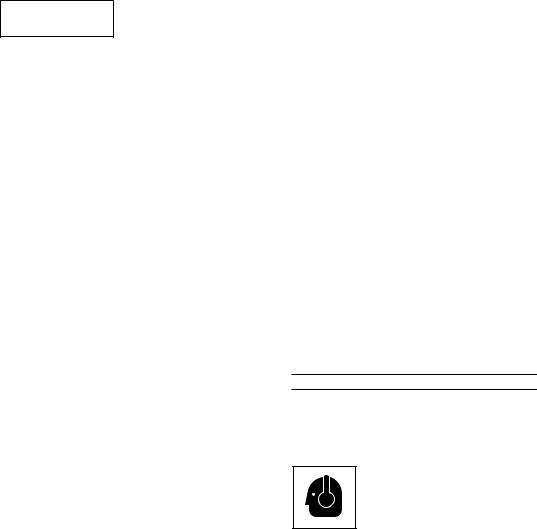
English
b)Use safety equipment. Always wear eye protection.
Safety equipment such as dust mask, nonskid safety shoes, hard hat, or hearing protection used for appropriate conditions will reduce personal injuries.
c)Avoid accidental starting. Ensure the switch is in the off position before plugging in.
Carrying power tools with your finger on the switch or plugging in power tools that have the switch on invites accidents.
d)Remove any adjusting key or wrench before turning the power tool on.
A wrench or a key left attached to a rotating part of the power tool may result in personal injury.
e)Do not overreach. Keep proper footing and balance at all times.
This enables better control of the power tool in unexpected situations.
f)Dress properly. Do not wear loose clothing or jewellery. Keep your hair, clothing and gloves away from moving parts.
Loose clothes, jewellery or long hair can be caught in moving parts.
g)If devices are provided for the connection of dust extraction and collection facilities, ensure these are connected and properly used.
Use of these devices can reduce dust-related hazards.
4)Power tool use and care
a)Do not force the power tool. Use the correct power tool for your application.
The correct power tool will do the job better and safer at the rate for which it was designed.
b)Do not use the power tool if the switch does not turn it on and off.
Any power tool that cannot be controlled with the switch is dangerous and must be repaired.
c)Disconnect the plug from the power source and/or the battery pack from the power toll before making any adjustments, changing accessories, or storing power tools.
Such preventive safety measures reduce the risk of starting the power tool accidentally.
d)Store idle power tools out of the reach of children and do not allow persons unfamiliar with the power tool or these instructions to operate the power tool.
Power tools are dangerous in the hands of untrained users.
e)Maintain power tools. Check for misalignment or binding of moving parts, breakage of parts and any other condition that may affect the power tools operation. If damaged, have the power tool repaired before use.
Many accidents are caused by poorly maintained power tools.
f)Keep cutting tools sharp and clean.
Properly maintained cutting tools with sharp cutting edges are less likely to bind and are easier to control.
g)Use the power tool, accessories and tool bits etc., in accordance with these instructions and in the manner intended for the particular type of power tool, taking into account the working conditions and the work to be performed.
Use of the power tool for operations different from intended could result in a hazardous situation.
5)Service
a)Have your power tool serviced by a qualified repair person using only identical replacement parts.
This will ensure that the safety of the power tool is maintained.
–WARNING–
To reduce the risk of injury, user must read instruction manual.
SPECIFIC SAFETY RULES AND SYMBOLS
1.Hold tools by insulated gripping surfaces when performing an operation where the cutting tool may contact hidden wiring or its own cord. Contact with a “live” wire will make exposed metal parts of the tool “live” and shock the operator.
2.ALWAYS wear ear protectors when using the tool
for extended periods.
Prolonged exposure to high intensity noise can cause hearing loss.
3.NEVER touch the tool bit with bare hands after operation.
4.NEVER wear gloves made from materials likely to roll up such as cotton, wool, cloth or string, etc.
5.ALWAYS attach the side handle and securely grip the Belt Sander.
6.NEVER touch moving parts.
NEVER place your hands, fingers or other body parts near the tool’s moving parts.
7.NEVER operate without all guards in place. NEVER operate this tool without all guards or safety features in place and in proper working order. If maintenance or servicing requires the removal of a guard or safety feature, be sure to replace the guard or safety feature before resuming operation of the tool.
4
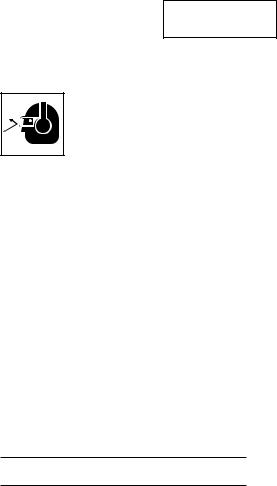
English
8.Use right tool.
Don’t force small tool or attachment to do the job of a heavy-duty tool.
Don’t use tool for purpose not intended —for example— don’t use circular saw for cutting tree limbs or logs.
9.NEVER use a power tool for applications other than those specified.
NEVER use a power tool for applications other than those specified in the Instruction Manual.
10.Handle tool correctly.
Operate the tool according to the instructions provided herein. Do not drop or throw the tool. NEVER allow the tool to be operated by children, individuals unfamiliar with its operation or unauthorized personnel.
11.Keep all screws, bolts and covers tightly in place.
Keep all screws, bolts, and plates tightly mounted. Check their condition periodically.
12.Do not use power tools if the plastic housing or handle is cracked.
Cracks in the tool’s housing or handle can lead to electric shock. Such tools should not be used until repaired.
13.Blades and accessories must be securely mounted to the tool.
Prevent potential injuries to youself or others. Blades, cutting implements and accessories which have been mounted to the tool should be secure and tight.
14.Keep motor air vent clean.
The tool’s motor air vent must be kept clean so that air can freely flow at all times. Check for dust build-up frequently.
15.Operate power tools at the rated voltage.
Operate the power tool at voltages specified on its nameplate.
If using the power tool at a higher voltage than the rated voltage, it will result in abnormally fast motor revolution and may damage the unit and the motor may burn out.
16.NEVER use a tool which is defective or operating abnormally.
If the tool appears to be operating unusually, making strange noises, or otherwise appears defective, stop using it immediately and arrange for repairs by a Hitachi authorized service center.
17.NEVER leave tool running unattended. Turn power off.
Don’t leave tool until it comes to a complete stop.
18.Carefully handle power tools.
Should a power tool be dropped or struck against hard materials inadvertently, it may be deformed, cracked, or damaged.
19.Do not wipe plastic parts with solvent.
Solvents such as gasoline, thinner benzine, carbon tetrachloride, and alcohol may damage and crack plastic parts. Do not wipe them with such solvents.
Wipe plastic parts with a soft cloth lightly dampened with soapy water and dry thoroughly.
20. ALWAYS wear eye protection that meets the requirement of the latest revision of ANSI Standard Z87.1.
21.Align the inside arrow mark of the sanding belt with the revolving direction of the drive pulley.
22.Sanding by applying impact and cutting by side- of-belt contact should be avoided.
23.Be careful of sanding sparks.
24.After operation sweep the sanding dust from the dust bag to avoid serious accidents.
25.Don't use water, or oil as lubricant.
26.Ascertain that the sanding workpiece contains neither nails nor other harmful foreign matter.
27.Sanding glass fiber not recommended.
28.After operation, blow away the dust on the belt and the pulleys.
29.Definitions for symbols used on this tool
V ............... volts Hz ............. hertz
A ............... amperes
no .............. no load speed
W .............. watt
 ............. Class II Construction
............. Class II Construction
---/min ...... revolutions or reciprocation per minute
 ............. Alternating current
............. Alternating current
DOUBLE INSULATION FOR SAFER OPERATION
To ensure safer operation of this power tool, HITACHI has adopted a double insulation design. “Double insulation” means that two physically separated insulation systems have been used to insulate the electrically conductive materials connected to the power supply from the outer frame handled by the operator. Therefore, either the symbol “ ” or the words “Double insulation” appear on the power tool or on the nameplate. Although this system has no external grounding, you must still follow the normal electrical safety precautions given in this Instruction Manual, including not using the power tool in wet environments.
” or the words “Double insulation” appear on the power tool or on the nameplate. Although this system has no external grounding, you must still follow the normal electrical safety precautions given in this Instruction Manual, including not using the power tool in wet environments.
To keep the double insulation system effective, follow these precautions:
Only HITACHI AUTHORIZED SERVICE CENTER should disassemble or assemble this power tool, and only genuine HITACHI replacement parts should be installed.
Clean the exterior of the power tool only with a soft cloth moistened with soapy water, and dry thoroughly.
Never use solvents, gasoline or thinners on plastic components; otherwise the plastic may dissolve.
5
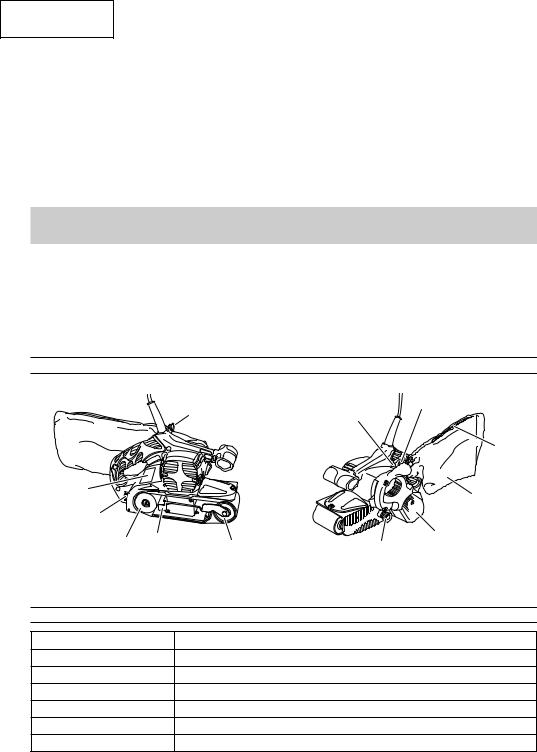
English
SAVE THESE INSTRUCTIONS
AND
MAKE THEM AVAILABLE TO OTHER USERS
AND
OWNERS OF THIS TOOL!
FUNCTIONAL DESCRIPTION
NOTE:
The information contained in this Instruction Manual is designed to assist you in the safe operation and maintenance of the power tool.
NEVER operate, or attempt any maintenance on the tool unless you have first read and understood all safey instructions contained in this manual.
Some illustrations in this Instruction Manual may show details or attachments that differ from those on your own power tool.
NAME OF PARTS
|
Support bar |
Stopper |
|
Trigger switch |
|
|
|
Slide |
|
|
fastener |
Nameplate |
|
Dust bag |
Dial |
|
|
|
|
|
Drive pulley Lever |
Idle pulley |
Belt cover |
|
Adjust screw |
|
Fig. 1-a |
|
Fig. 1-b |
SPECIFICATIONS |
|
|
Model |
|
SB8V2 |
Motor |
Single Phase, Series Commutator Motor |
|
Power source |
Single Phase 120V AC 60 Hz |
|
Current |
|
9.0 A |
Sanding belt size |
3” × |
21” (76 mm × 533 mm) |
No-load belt speed |
820 – 1,476 ft/min (250 – 450 m/min) |
|
Weight (without cord) |
|
9.5 lbs (4.3 kg) |
6
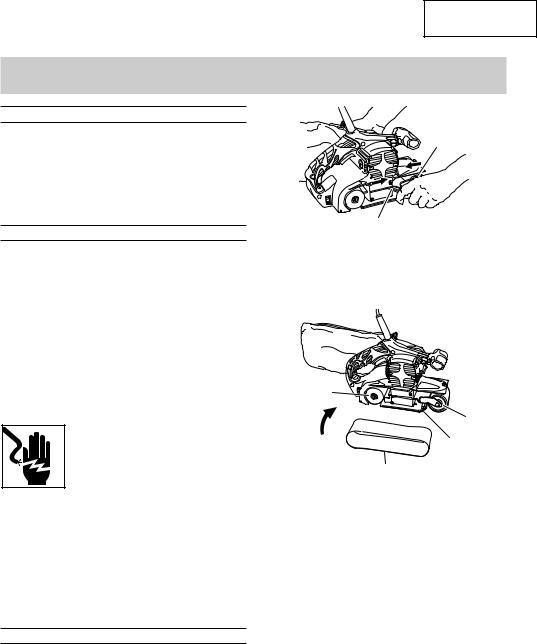
English
ASSEMBLY AND OPERATION |
|
APPLICATIONS |
|
Sanding finish and flooring finish of woodwork |
Idle pulley |
products. |
|
Base polishing of Lumber-coated planes. |
|
Sandfng finishes of metal surfaces. |
|
Base polishing of metal-coated planes, rust |
|
removal, or paint removal paint to refinishing. |
|
Surfacial finish of slate, concrete, and so on. |
|
PRIOR TO OPERATION
1.Power source
Ensure that the power source to be utilized conforms to the power source requirements specified on the product nameplate.
2.Power switch
Ensure that the switch is in the OFF position. If the plug is connected to a receptacle while the switch is in the ON position, the power tool will start operating immediately and can cause serious injury.
3.Extension cord
When the work area is far away from the power source, use an extension cord of sufficient thickness and rated capacity. The extension cord should be kept as short as practicable.
 WARNING:
WARNING:
Damaged cord must be replaced or repaired.
4.Check the receptacle
If the receptacle only loosely accepts the plug, the receptacle must be repaired. Contact a licensed electrician to make appropriate repairs.
If such a fautly receptacle is used, it may cause overheating, resulting in a serious hazard.
5.Confirming condition of the environment: Confirm that the work site is placed under appropriate conditions conforming to prescribed precautions.
HOW TO HANDLE SANDING BELT
 WARNING:
WARNING:
Be sure to switch power OFF and disconnect the plug from the receptacle to avoid serious trouble.
1.How to attach sanding belt
(1)Pull lever with finger, idle pulley will then move backward.
Lever
Fig. 2
(2)Place on drive pulley and idle pulley passing it over the outside of shoe plate and making sure that arrow on inside of belt coincides with rotational direction of drive pulley.
Drive pulley |
|
Rotational |
Idle |
direction |
pulley |
|
Shoe plate |
|
Sanding belt |
|
Fig. 3 |
(3)Push lever with finger, idle pulley will then move forward and give proper tension to sanding belt. In this case, be careful not to be hit your finger by lever.
Then, adjust sanding belt position. (refer to page 8)
 CAUTION:
CAUTION:
Sanding belt installed in the wrong direction will lower work efficiency and shorten life of sanding belt.
2.How to remove sanding belt
Pull lever with finger, sanding belt will then sag and can be taken off pulleys eqsily.
DUST REMOVAL
When an excessive amount of dust is deposited in the dust bag, dust-collecting efficiency will sharply drop. Remove dust from the bag when it is deposited up to about 2/3 the bag capacity, where by dust collecting efficiency (as well as working efficiency) will be ensured.
7

English
Remove dust from the bag as follows:
(1)Loosen the support bar and remove the dust bag.
(2)The bag inlet can be opened by unzipping the slide fastener.
HOW TO USE THE BELT SANDER
1.How to adjust sanding position.
Push switch and turn sanding belt te check position. Adjust sanding belt so that both edges protrude 1/6"–1/8" (1.6mm–3mm) past edges of pulleys.
lf sanding belt is operated too far on the inside, it may ceuse abrasion and damage machine. Adjust sanding belt position by turning adjust screw (Fig. 4 )
Turn adjust screw clockwise to move belt in.
Turn adjust screw counterclockwise to move belt out.
 CAUTION:
CAUTION:
If sanding belt moves during operation, adjustment can be made while in operation.
Adjust screw
Out side
In side
Fig. 4
2.To turn on switch
Turn on switch while holding machine away from surface to be worked on. If machine is placed on surface when switch is pushed, surface may be badly scratched.
The same applies when stopping the machine.
3.How to hold machine
Grasp handle and handle knob and hold machine against surface to be worked on so that it contacts surface lightly.
Weight of machine itself is sufficient for sanding and polishing at highest efficiency.
Do not apply any additional pressure, for this would place unnecessary load on motor, shorten life of sanding belt and lower work efficiency.(Fig. 5)
4.How to move machine
Move mechine forward first and then backward, repeating this motion.(Fig. 5)
Move
Fig. 5
5.How to select proper sanding belt
Choose sanding belt of proper grain size and grain type for your specific purpose, by referring to Table 1 and 2 below.
Table 1
Derived finish |
|
Proper grain size |
|
Coarse finish |
|
30-40 |
|
Medium finish |
|
40-100 |
|
Semi fine finish |
|
80-240 |
|
Fine finish |
|
180-400 |
|
Table 2 |
|
|
|
Grain type |
Surface to be worked on |
||
AA |
Steel, Wood |
|
|
WA |
Wood, Bamboo |
|
|
 CAUTION:
CAUTION:
●For grain sizes, refer to Table 2
●Sanding belt grain should be coarser than sandpaper used for manual work.
●Use sanding belt of same grain size until uniform surface is obtained. Changing grain sizes may result in poor finish.
8
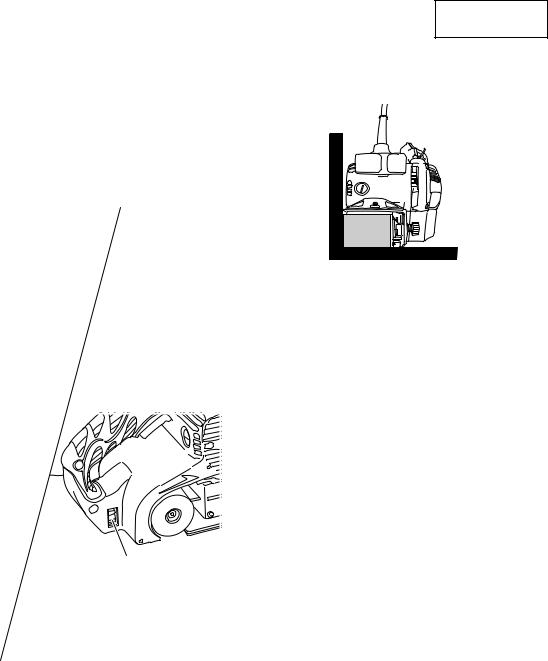
English
6.How to operate switch
The power switch is turned ON when the trigger is pulled, and if the stopper is once depressed, the power switch becomes locked, allowing continuous operation.
The stopper can be released pulling the trigger. (Fig. 6)
Stopper
Fig. 6
7.Adjusting the belt speed
The Belt Sander is equipped with the electric control circuit which enables stepless speed control. To adiust the speed, turn the dial shown in Fig. 7
When the dial is set to “1”, the belt sander operates at the minimum speed. When the dial is set to “5” , the belt sander operetes at the maximum speed.
Dial
Fig. 7
8.How to work on corner
Corners can be sanded and polished by using machine as in Fig. 8.
Fig. 8
9

English
MAINTENANCE AND INSPECTION
 WARNING:
WARNING:
Be sure to switch power OFF and disconnect the plug from the receptacle during maintenance and inspection.
1.Inspecting the screws
Regularly inspect all screws and ensure that they are fully tightened. Should any of the screws be loosened, retighten them immediately.
 WARNING:
WARNING:
Using this belt sander with loosened screws is extremely dangerous.
2.Maintenance of the motor
The motor unit winding is the very “heart” of the power tool. Exercise due care to ensure the winding does not become damaged and/or wet with oil or water.
3.Service and repairs
All quality power tools will eventually require servicing or replacement of parts because of wear from normal use. To assure that only authorized replacement parts will be used, all service and repairs must be performed by a HITACHI AUTHORIZED SERVICE CENTER, ONLY.
4.Service parts list
 CAUTION:
CAUTION:
Repair, modification and inspection of Hitachi Power Tools must be carried out by a Hitachi Authorized Service Center.
This Parts List will be helpful if presented with the tool to the Hitachi Authorized Service Center when requesting repair or other maintenance. In the operation and maintenance of power tools, the safety regulations and standards prescribed in each country must be observed.
MODIFICATIONS:
Hitachi Power Tools are constantly being improved and modified to incorporate the latest technological advancements.
Accordingly, some parts may be changed without prior notice.
ACCESSORIES
 WARNING:
WARNING:
ALWAYS use Only authorized HITACHI replacement parts and accessories. Never use replacement parts or accessories which are not intended for use with this tool. Contact HITACHI if you are not sure whether it is safe to use a particular replacement part or accessory with your tool. The use of any other attachment or accessory can be dangerous and could cause injury or mechanical damage.
NOTE:
Accessories are subject to change without any obligation on the part of the HITACHI.
STANDARD ACCESSORIES |
|
|
(1) |
Endless Sanding Belt (Code No. 939733) ........... |
1 |
(2) |
Dust Bag (Code No. 323011) ................................ |
1 |
10

English
OPTIONAL ACCESSORIES …………… sold separately
Endless Sanding Belts
Code |
Grain |
Grain |
Belt Size |
||
No. |
size |
Type |
|||
|
|
||||
939731 |
40 |
|
|
|
|
939732 |
60 |
|
|
|
|
939733 |
80 |
|
|
|
|
939734 |
100 |
WA |
|
|
|
939735 |
120 |
|
|
||
|
|
|
|||
939736 |
150 |
|
|
|
|
939737 |
180 |
|
|
|
|
939738 |
240 |
|
|
|
|
939739 |
30 |
|
3” × |
21” |
|
939740 |
40 |
|
|||
|
(76 mm × |
533 mm) |
|||
939741 |
60 |
|
|||
|
|
|
|||
939742 |
80 |
|
|
|
|
939743 |
100 |
|
|
|
|
939744 |
120 |
AA |
|
|
|
939745 |
150 |
|
|
|
|
939746 |
180 |
|
|
|
|
939747 |
240 |
|
|
|
|
939748 |
320 |
|
|
|
|
939749 |
400 |
|
|
|
|
NOTE:
Specifications are subject to change without any obligation on the part of the HITACHI.
11
